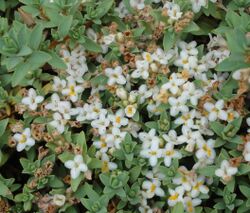Biology:Pimelea prostrata
| Pimelea prostrata | |
|---|---|

| |
| Scientific classification | |
| Kingdom: | Plantae |
| Clade: | Tracheophytes |
| Clade: | Angiosperms |
| Clade: | Eudicots |
| Clade: | Rosids |
| Order: | Malvales |
| Family: | Thymelaeaceae |
| Genus: | Pimelea |
| Species: | P. prostrata
|
| Binomial name | |
| Pimelea prostrata Willd.[1]
| |
Pimelea prostrata, commonly known as Strathmore weed, New Zealand Daphne, and Pinatoro (Māori) is a species of small shrub, of the family Thymelaeaceae. It is endemic to New Zealand and has small white flowers and blue green leaves.[2][3]
Description
Pimelea prostrata is a low growing Prostrate shrub. It has blue green leaves and small white flowers.[1] Its stems range from 30 to 60 cm long, depending on the variety.[4]
- Pimelea prostrata subsp. prostrata has 30cm long stems and yellowish-brown branchlets.
Classification
Pimelea prostrata has five subspecies:[4]
- Pimelea prostrata subsp. prostrata
- Pimelea prostrata subsp. seismica
- Pimelea prostrata subsp. thermalis
- Pimelea prostrata subsp. ventosa
- Pimelea prostrata subsp. vulcanica
Etymology
Pimelea is the shortened version of the Greek: Pimeleoides, which means "resembling Pimelea," a genus in the family Thymelaeaceae, prostrata describes the way in which it grows; Prostrate lying flat on the ground.[3]
Toxins
Like many species of Pimelea, it is poisonous to animals, particularly horses. It was originally used as a source of the toxin prostratin, which can serve as a tumor-inhibiting agent.[2]
References
- ↑ 1.0 1.1 "Pimelea prostrata subsp. prostrata". 6 December 2014. http://www.nzpcn.org.nz/flora_details.aspx?ID=1125.
- ↑ 2.0 2.1 "Strathmore Weed". Te Ara Encyclopedia of New Zealand. http://www.teara.govt.nz/en/plant-extracts/3/4.
- ↑ 3.0 3.1 "Pimelea prostrata subsp. prostrata" (in en). https://www.nzpcn.org.nz/flora/species/pimelea-prostrata-subsp-prostrata/.
- ↑ 4.0 4.1 "Flora search results" (in en). https://www.nzpcn.org.nz/flora/species/.
Wikidata ☰ Q17582290 entry
 |

